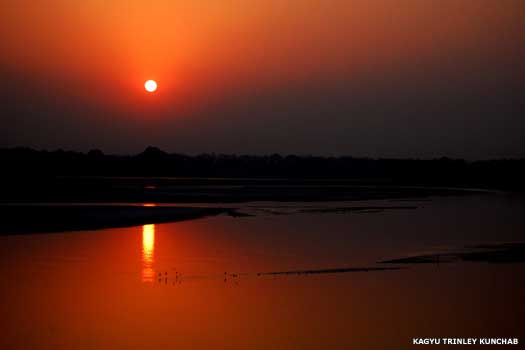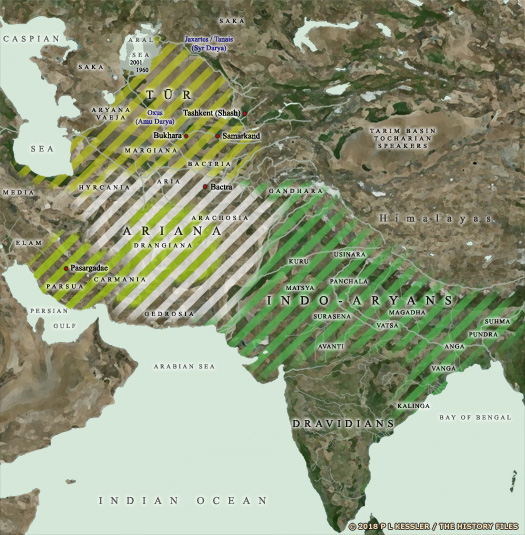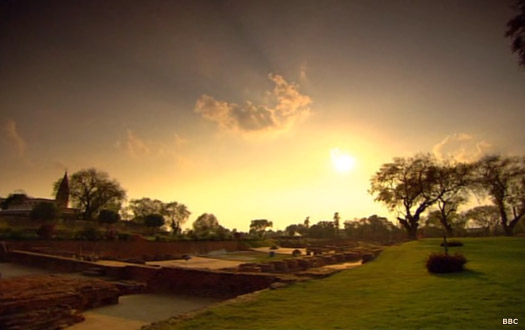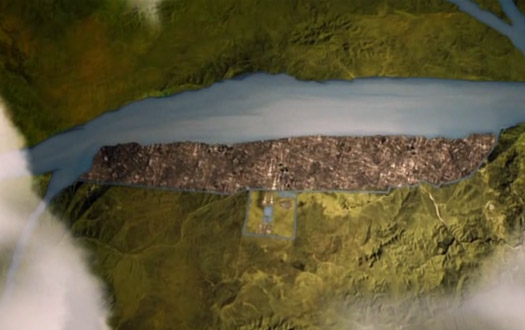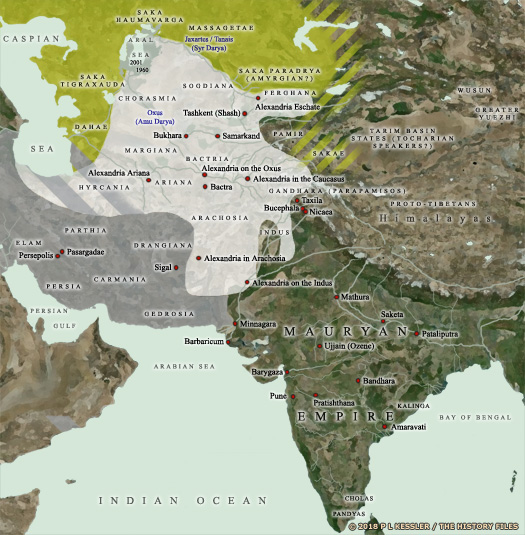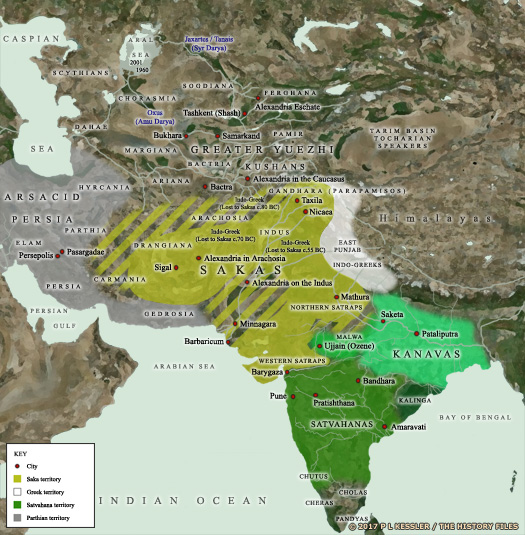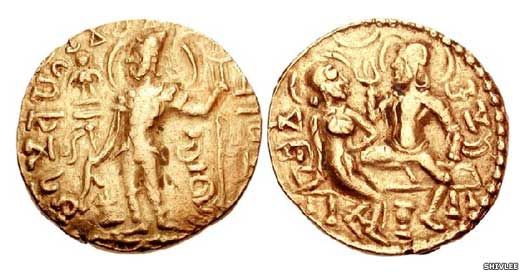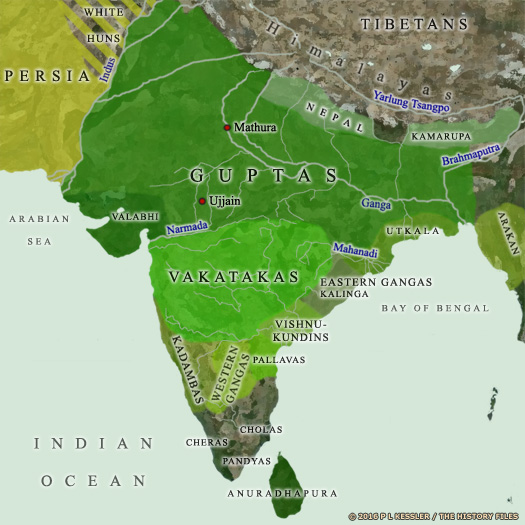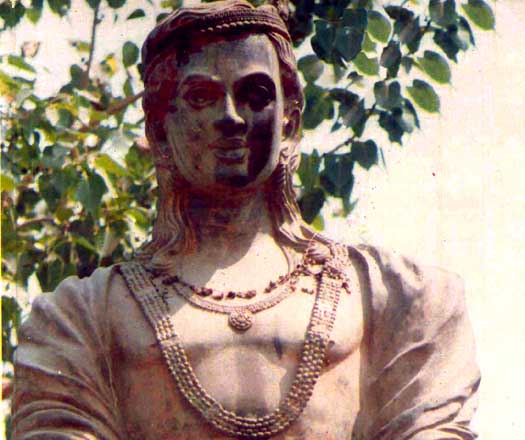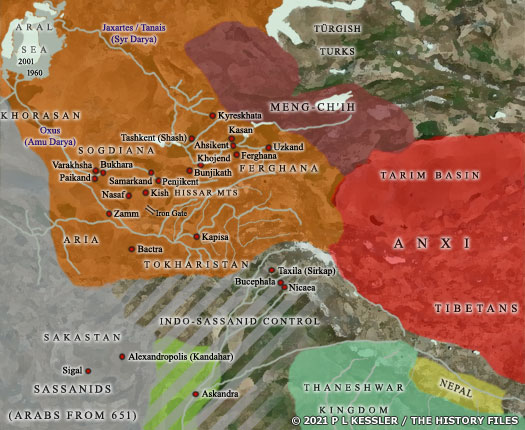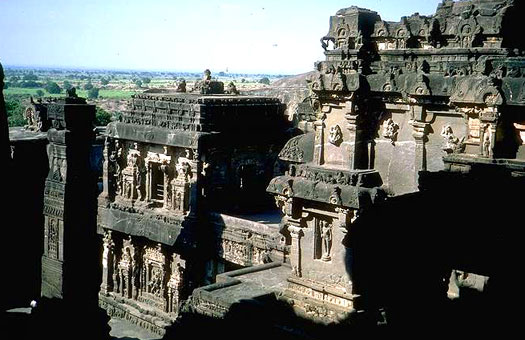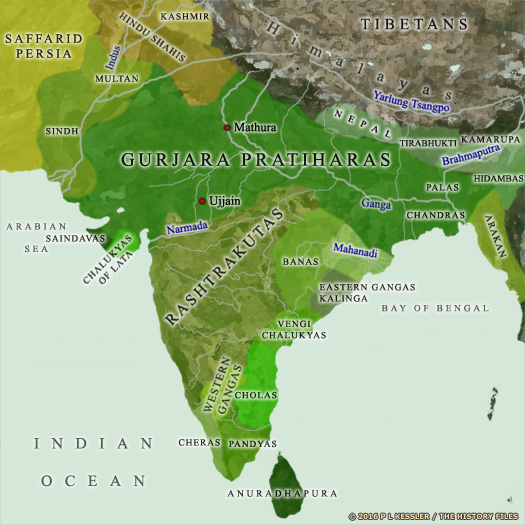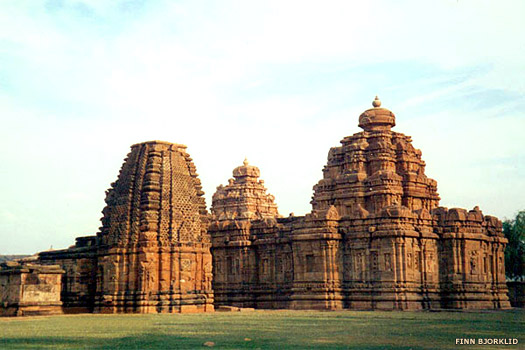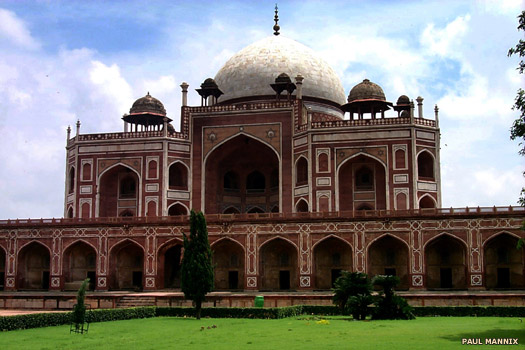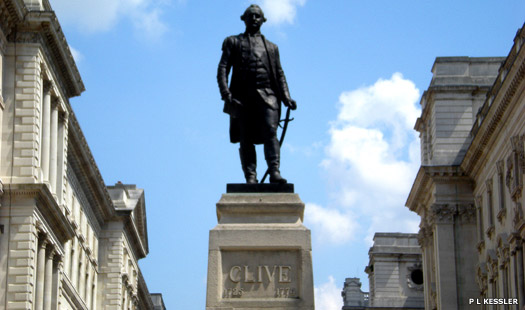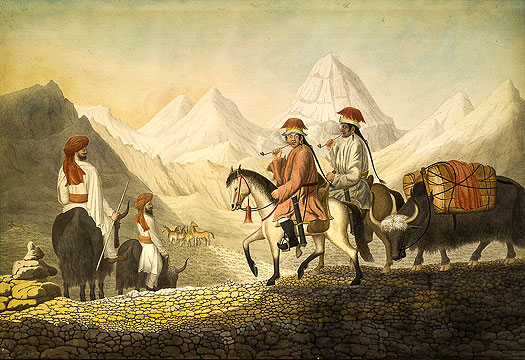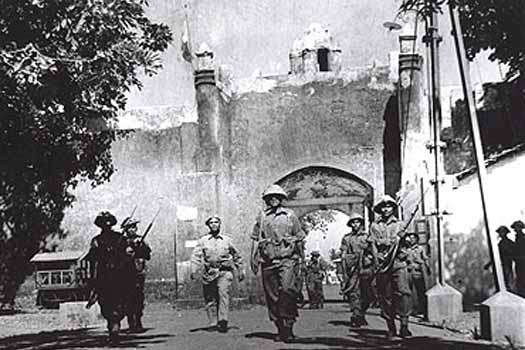
| INDIA (ARYAVRAT / BHARAT) India in South Asia has been inhabited since about 70,000-60,000 BC - one of the earliest locations to be permanently inhabited by hunter-gatherers who had emerged from Africa up to 10,000 years before. That hunter-gatherer culture survived in the rich, verdant, and extremely fertile country of the sub-continent until the first permanent settlements emerged around 7000 BC in the Indus river valley, such as at Mergarh in modern Baluchistan. The next migration into India originated in the Zagros region in south-western Iran, and this brought agriculturists, most likely herders, into the sub-continent between 7000 and 3000 BC. These Zagrosian herders intermixed with the earlier inhabitants of the subcontinent and together they formed the the Indus Valley culture. However, while this provided an early flowering of civilisation in north-western India in the third millennium BC, its demise around 1700 BC left South Asia without an urban culture until small cities emerged in the east, in the Ganges valley and northern India.
During the later years of the Indus Valley culture, and that of its more northerly counterpart, the Bactria-Margiana Archaeological Complex (BMAC), climate change was clearly having an affect. The rains were drying up and cities were gradually being abandoned. Sophisticated Bronze Age chariot-riding, cattle-herding Indo-Europeans (IEs) from the north became more greatly integrated into this region and eventually they took it over. By 1500 BC, these new folk had begun to filter into India from the north-west, from the direction of modern Afghanistan, displacing or mixing with the native Elamo-Dravidian peoples. This particular branch of Indo-Europeans were the Indo-Aryans. They were a division of the Indo-Iranians who remained in Central Asia and who populated the civilised zone between Ferghana and Persia, but the Indo-Aryans may have preceded that particular takeover because it can be seen that they reached people and areas that would only later be dominated by Indo-Iranians, such as the Hurrians of Mitanni.
The Indo-European word 'arya' meant the 'civilised' or 'respectable' according to general scholarly opinion (the rather tainted 'Aryan' term has been replaced by modern scholars with the more accurate 'Indo-Aryan'). This word, added to a plural suffix, possibly -na, produced Aryana, which is how these people referred to themselves. The East Indo-Europeans who supplied the tribes which formed the Indo-Aryans and Indo-Iranians were documented as calling themselves Aryans when they entered India. This rather elitist naming is explained as a reaction to the apparently barbarous people they encountered in India, although an earlier reason may supply the true meaning because the name clearly predated the migration into India (its survival in Central Asia and Iran shows this). The 'barbarous people' were probably those of the forager cultures encountered when the IEs first migrated to the east of the Caspian Sea.
The Indo-Aryans shared a common language base with the other Indo-European groups which were spreading west and south from the Pontic-Caspian steppe above the Black Sea and Caspian Sea and which later formed the basis of languages such as Greek, Persian, and Latin. Even by the eighteenth century AD, similarities between the languages, which in India emerged as Sanskrit, could easily be spotted by philologists. The earliest Sanskrit texts, the Vedas (and in particular, Rig Veda) chart an Indo-European migration from Afghanistan (where rivers with recognisable names are mentioned) into north-western India, notably Peshawar, where they settled along the Indus Valley, the river which gave India its name.
(Additional information by Edward Dawson. Details on the migration of the Indo-Europeans into India from the BBC series, The Story of India, by Michael Wood, first broadcast between August-September 2007. Further additional information from The Horse, the Wheel, and Language: How Bronze-Age Riders from the Eurasian Steppes Shaped the Modern World, David W Anthony, from the Encyclopaedia of Indo-European Culture, J P Mallory & D Q Adams (Eds, 1997), from Early Indians: The Story of Our Ancestors and Where We Came From, Tony Joseph (Juggernaut, 2018), and from External Links: Indo-European Chronology - Countries and Peoples, and Indo-European Etymological Dictionary, J Pokorny.)
c.1500 BC :
The first signs of Indo-European culture emerges between Peshawar and the Ganges Plain. The latter region, in modern Bihar, witnesses the first and greatest of Indian kingdoms, that of Magadh. This migration into India by Indo-Europeans and the founding of their first kingdoms is highly controversial in modern India, with some arguments even going to state that there is no such 'invasion'. The consensus of more considered opinion is that it does indeed happen and that much of the accepted information below is largely true (even if individual facts may seem rather shaky).
The Ganges Plain saw the rise of the first northern Indian kingdoms from around the sixteenth century BC onwards Kingdom of Magadh :
This was one of the first kingdoms to be founded by the newly arrived Indo-Aryans in India after 1500 BC. The heart of the early Aryan territory was the region of Peshawar in modern Pakistan, but the Magadhs may have been amongst the first to venture further eastwards. Centred on the Ganges Plain, in modern Bihar, their kingdom was one of the sixteen 'Great Countries' or regions (Mahājanapads, in Sanskrit). The kingdom later spread out to encompass much of India during an era of heroic warfare which came to be crystallised as the Indian epic, the Mahabharata. The first capital was Rajagah (modern Rajgir) before being transferred to Pataliputra (modern Patna).
The early rulers, down to the sixth century BC are almost entirely unknown outside traditional texts, such as the Purans, and Buddhist and Jain texts. Although India's strong oral culture means the list of kings is probably reliable, it is open to much debate. The Haryanka ruler, Bimbisara, is the first of the Magadhn kings to be dated with anything approaching accuracy, and the dates of those before him are calculated backwards using assumed lengths of rule. Modern Indian historians tend to assume longer lengths, pushing the start of this list back to an earlier date than is shown here. This has the effect of placing the earliest Magadh rulers in Peshawar, or still on the migratory trail into India, whereas here they are assumed to have already infiltrated the Ganges Plain before their first Indian (as opposed to Indo-Aryan migration) dynasty is proclaimed.
The Janapadas (kingdoms) of the Vedic period also included a shifting number of other kingdoms, all of which vied for control and supremacy as they assimilated the native Dravidic people and stamped their culture on northern India. These included the Druhyus of the seven rivers (immediately to the east of the River Indus), who were driven out by Mandhatr. They resettled on the western side of the Indus to dominate the Indo-Aryan Gandhari people.
Sudhanu Dynasty :
According to the Srimad Bhagavatm (Bhagavat Puran), the story of Krishna, one of Hinduism's most important texts, 'Another son of Ajamidha was named Rksa. From Rksa came a son named Samvarana, and from Samvarana came Kuru, the king of Kuruksetra [the scene of the great war in the Mahabharata, composed between about 400 BC-AD 400]. Kuru had four sons: Pariksi, Sudhanu, Jahnu and Nisadha'. Sudhanu inherited the kingdom which became Magadh.
fl c.1460? BC :
Sudhanu
Suhatra / Suhotra : Son.
Chyavana / Cyavana : Son.
fl c.1400? BC :
Kriti / Krti : Son.
Uparicara Vasu : Son.
Brhadratha Dynasty :
It seems likely that the powerful Magadh kingdom was established on the Ganges Plain by these legendary kings. The second of them, Jarasandh, is mentioned in the Puran texts as a son of Brhadratha. He also appears in the Mahabharata as the 'Magadhn emperor who rules all India', although he was killed in single combat by one of three assassins from the kingdom of Kuru, who were concerned with liberating the many captive kings he held. The long line of kings who succeeded him are all mentioned in the Buddhist, Hindu, and Jain texts. By this time, other Indo-Aryan kingdoms had apparently emerged alongside Magadh, notably (but not exclusively) in the east, including Ang, Kaling, Pundra, Sindhu, Suhma, and Vang. The Assam region was also enjoying its first flush of kingship.
The list of legendary Brhadratha kings shown in black is from the Vayu Puran, but the the Matsya Puran shows a list of names which differs in places, and these are inserted where appropriate in red.
(Additional information by Abhijit Rajadhyaksha and Edward Dawson.)
fl c.1360? BC :
Brhadratha : Son of Uparicara Vasu.
Jarasandha : Son. Crowned emperor of Magadh.
c.1300? BC :
One of Jarasandh's contemporaries is Jayatsen of Magadh, probably an ally and vassal who rules a section of the kingdom independently after Jarasandh's death. Jayatsen takes part in the Kurukshetra War in the Mahabharat as one of the leaders on the side of the Kauravas, along with Srutayus of Kaling, Paundrak Vasudev of Pundra, Karna of Ang, and Malayadwaj of the Pandyas. Bhagadata of the Narak kings is also involved in the war.
Jarasandh is killed by Bhima, one of the heroes of the Mahabharat, who slays him after an intense fight (of twenty-seven days) on the advice of Lord Krishna, who is revered as a god. He is the second assassin of the three, the final one being Arjuna (Bhima's brother and a superb archer), the illustrious pivotal character in the Mahabharata.
Somapi : Son.
Shrutashrava / Srutasravas : Son.
Ayutaya / Ayutayus (Apratipa)
Niramitra : 'Mitra' is an Indo-European source word for 'metre' and 'metric'.
Suksatra / Sukshatra / Sunaksatra : Son.
fl c.1100? BC :
Brhatkarman / Brihatkarman : Son?
Brihatsen : The same as Brhatkarman?
Senajit
Shrutanjaya / Sutanjayat
Vipra / Vibhu (Vidhu)
Shuci / Suchi : Son of Shrutanjay.
fl c.1000? BC :
Ksemya / Kshemya
Suvrat / Subrat
Sunetra : Joint ruler or sub-king with Suvrata from 29th year of his reign.
Dharmanetra / Dharma : In the Vayu Puran only.
Susuma (Sushrama?) : In the Vayu Puran only.
Drdhasen / Dridhasen : In the Vayu Puran only.
fl c.900? BC :
Nivritti / Nivrati
Sumati : In the Vayu Puran only.
Suvala / Subhala : In the Vayu Puran only.
Trinetra
Sunita : In the Vayu Puran only.
Mahatsena
Satyajit : In the Vayu Puran only.
Sunik / Pradyota Dynasty :
There are two conflicting claims for the founder of this dynasty, with both the first two rulers being given the honour. According to the Vayu Puran, the Pradyotas ruled Magadh for 138 years from 799-684 BC, when they were displaced by the Shishunagas who rose up during a period of lawlessness in the kingdom (but see the Sisunaka dynasty for more on the confusion over Shishunaga in c.684 and 410 BC). In support of this, the dynasty ends with Varttivarddhan in most lists, with Shishunag's successors here mostly being repeated in the Sisunaka list.
fl c.700? BC :
Sunika / Punika
Pradyota Mahasena
Palak : Son.
Palak conquers Kaushambi (in modern Uttar Pradesh), strengthening the kingdom.
Following the climate-change-induced collapse of indigenous civilisations and cultures in Iran and Central Asia between about 2200-1700 BC, Indo-Iranian groups gradually migrated southwards to form two regions - Tūr (yellow) and Ariana (white), with westward migrants forming the early Parsua kingdom (lime green), and Indo-Aryans entering India (green) Vishakhayup
Janaka / Ayak / Aryak / Ajak
Varttivarddhan / Nandivardhan
c.684 - ? BC :
Shishunag : Possibly confused with Sisunaga (410-392 BC).
fl c.600? BC :
Kakavarna
Kshemadharman
Kshatraujs
Haryank Dynasty :
Bimbisar founded a new dynasty and showed great energy in expanding the kingdom, either through conquest or marriage, subjecting the rival kingdom of Anga in what is now western Bengal via the former means. His son, Ajatshatru, completed his work, strengthening the capital at Rajagrih and expanding westwards up the Ganges. The capital was later transferred to Pataliputra (modern Patna in Bihar) by Ajatshatru. Confusingly, Bimbisar is also claimed for the Shishunag dynasty beginning in c.684 BC, perhaps indicating that the use of Haryank as a dynasty name is a later modification.
c.546 - 530 BC :
Just as the Haryankas are founding their new dynasty in eastern India, Cyrus the Great sweeps through South Asia and the Hindu Kush. Under his command, the Persians enter the Indus Valley and create the province of Thatagush, although records for these campaigns are characteristically sparse.
c.543 - 491 BC :
Bimbisar : Murdered by his son.
c.543 BC :
While still crown prince, Bimbisara had killed King Bramhadatta of Anga and annexed his state. Now it seems that Anga is absorbed into the increasingly powerful Magadhn state by Bimbisara.
c.491 - 459 BC :
Ajatashatru : Son. (Or ruled c.551-519 BC)
Gaining the kingdom by murdering his father, Ajatshatru is also a contemporary of Gautam Buddh (c.563-483 BC, but many dating variations are proposed by various scholars). He strengthens the kingdom by annexing the rival kingdoms of Kashi and Kosaa, is at war with the Vriji Confederacy for sixteen years, and defeats the fractured Lichchhavi kingdom north of the Ganges.
After he had crystallised the tenets of the Eightfold Path in his mind, the Buddha travelled from Bodh Gaya to Sarnath, site of the First Sermon Darshak : Descent unknown, and not shown in all lists.
c.459 - 443 BC :
Udayin / Udayibhadra : Son of Ajatshatru.
c.443 - 439 BC :
Anuruddh : Cousin of Buddh. Succeeded through assassination.
c.439 - 435 BC :
Mund : Son. Succeeded through assassination.
c.430 BC :
The earliest ancestor figure for the Chera kings of southern India is dated to this period. He is Vanavaramban, and his unnamed successors term themselves the 'Vanavar', the 'celestials', with it being common for Hindu (and also early Germanic) dynasties to refer to themselves by the name of a founding figure. The gap between him and the next ruler who can be listed with any certainty can be accounted for by the lack of records for the state, and probably also by its unimportance.
c.435 - 410 BC :
Nagdasak : Son. Succeeded through assassination.
c.410 BC :
The continuing bloodshed in the dynasty probably leads to a civil war in which the Haryanks are replaced by their former court officials, the Sisunaks.
Sisunaka Dynasty (Shishunaga) :
Some sources state that the Sisunagas began with the Shishunaga of c.684 BC, and there seems to be some confusion over whether they were one and the same person or two entirely separate rulers. The second appearance of the name, Sisunaga, is used here as the founder of his eponymous dynasty. The Magadh capital remained at Pataliputra.
410 - 392 BC :
Sisunag / Shishunag : Former amatya (official) under the Haryankas.
392 - 380 BC :
Kalasok
380 - 358 BC :
Kalasok's ten sons rule the kingdom in succession over the course of the next twenty-two years, the most prominent being :
Nandivardhan : One of the ten sons of Kalasok.
Ksemadharman : Repeated from the Pradyota list.
Ksemajit or Ksatraujs : Repeated from the Pradyota list.
Bimbisar : A repetition of the king of c.543 BC?
? - 344? BC :
Mahanandin : Chandragupt Maurya is claimed as his possible son.
Nand Dynasty :
The Sisunakas were overthrown by Mahapadma Nand, first of the 'Nine Nands'. He is said to have been an illegitimate son of the last Sisunak ruler, Mahnandin, or at least, of low birth. The other eight Nand monarchs were all the sons of Mahapadma. Under the Nands, the kingdom regained its western Indian territories for a time, right up to the border of modern Pakistan. It also extended south to the Deccan plateau.
One interesting theory regarding the Nand kings, put forward by Dr Ranajit Pal, suggests they were not originally based in Bihar but were instead from Magan in the west. Inscription and name evidence seems to suggest that Darius II and Artaxerxes III of Persia may have been Nand kings, although there is no other proof for a Persian presence so far east.
c.370 - 324 BC :
Mahapadma Nand : Son of Sisunak Dynasty's Mahanandin? Died aged 88.
Over the course of his long reign, according to the Mahabharat, Mahapadma Nand defeats many rival kings and tribes, including the Asmaks, Haihayas, Ikshvaku dynasty, Kalingas, Kasis, Kurus, Maithilas, Panchalas, Sursens, and Vitihotras.
Pandhuk : Son.
Panghupati : Brother.
Bhutapal : Brother.
Rashtrapal : Brother.
Govishanak : Brother.
Dashasidkhak : Brother.
Kaivart : Brother.
? - c.321 BC :
Dhana Nand / Argames : Brother. Aggrammes or Xandrames to the Greeks.
327 - 326 BC :
Alexander the Great's Macedonian army enters western India through the passes of the Hindu Kush, aided by King Ambhi of Taxila in Northern Indus (Punjab) in his war against Porus of Paurava and by the Sakas under Omarg. But it is in Punjab his troops rebel against the prospect of more battles against another great army on the Ganges. Alexander is forced to pull back, abandoning his hopes of conquering India. However, a swathe of minor states across north-western India remain his vassals.
c.321 BC :
Dhana is defeated by the young son of a Nand prince (or the son of a village headman - opinion is divided), who is called Chandragupt Maurya, and then murdered (by assailant(s) unknown), because he is apparently despised due to his low birth, and his wickedness. The once-great Magadh kingdom comes to an end as the Nand dynasty fails to hold onto power. Initially, in name at least, the victorious Mauryan empire retains the Magadh name.
Mauryan
Empire :
Possibly because of the pressure exerted by the Persian empire, which governed a larger area of conquered territory than any preceding empire, around its margins there developed various other centralised territorial states, including the Macedonian kingdom in Greece. The arrival of Alexander the Great into India also inspired the creation of India's first true empire, the Mauryan empire in northern India, which remains one of the country's greatest. At the behest of his teacher, who had been a subject of Dhana Nand and who had fled when his father had been murdered by the king, Chandragupt Maurya conquered the ancient northern Indian kingdom of Magadh, defeated its ruling Nand dynasty and incorporating its territory into the heart of his new empire. He retained the Magadh capital at Pataliputra, where his former teacher, Vishnugupt Chanakya, became his prime minister.
When Chandragupt encountered the Greek forces which Alexander the Great left in India, they knew him as Sandrokotos. His conquests in Macedonian-controlled northern India caused the vassal states to assassinate the Greek satrap of the Northern Indus (Punjab) in 325 BC, one Philip, thereby helping to speed up the final severing of Greco-Bactrian control of north-western India.
(Additional information by Abhijit Rajadhyaksh, and Madhu Nimkar, from the Mudrarakshasa, Vishakhadatt (Playwright), from the Parishishtaparvan, Acharya Hemachandra, and from External Link: Encyclopædia Britannica.)
c.324 - 301 BC :
Chandragupt Maurya : Founder of the empire in 321 BC.
321 BC :
Following his coronation, Chandragupt embarks on his conquest of a large swathe of the rest of India, starting with central India. He overcomes all opposition in the territory up to the north of the River Narmada. Ancient authors mention an alliance between Chandragupt and the Himalayan King Parvataka (a figure who is sometimes identified as the King Porus of Paurava who had been an ally of the Greeks since 326 BC).
305 - 303 BC :
Following the failure of Seleucus Nicator's Greek reconquest of India, the Indo-Greek regions of Paropamisadae, Arachosia, Gandhar, Northern Indus (Punjab), and probably also Southern Indus are ceded to the Mauryan empire by the Seleucids as part of an alliance agreement. This territory also includes the former kingdoms of Taxila and Paurav in the Indus. Subsequent relations between the Greeks and the Mauryans appear to be cordial. Seleucus even appoints Megasthenes as his ambassador to Chandragupt's court.
Chandragupt's Mauryan capital of Pataliputra (modern Patna) is shown here in computer-generated form as it would have appeared from the air in the fourth century BC Bindusar Maurya 'Amitraghat' : Son. Gained Deccan plateau. Amitrochates to the Greeks.
301 - 269 BC : Sushima : Son. Defeated in the succession war by Ashok.
273 - 269 BC :
There is a war of succession in the empire, in which Ashok is said to fight his ninety-nine brothers, probably referring to seemingly insurmountable odds. Ultimately Ashok is victorious and claims the throne.
269 - 232 BC :
Ashok (Ashokvardhan) Maurya : Brother. Buddhist.
c.261 BC :
During his reign, Ashok manages to extend the empire's borders to cover almost the entire subcontinent, save the southern tip and Sri Lanka. Perhaps his greatest feat as a military commander is the conquest of the kingdom of Kalinga and its ruler, Kumar. The conflict devastates large swathes of the populace and his own army. Witnessing the destruction, Ashok renounces violence and becomes a Buddhist.
250 BC :
In his role as a devout Buddhist, Ashok visits Nepal on pilgrimage.
Some historians theorise that Ashok and Diodotus II of Bactria are one and the same, and there evidence to support the theory. After his death, Ashok's sons dispute the title and (as in Bactria) the empire starts to crumble. Kalinga is one of the first to separate.
232 BC : Kunal / Kunala : Son. Blinded by one of Ashok's wives.
232 - 224 BC :
Dashrath : Succeeded when half-brother Kunal became blind.
224 BC :
All of the subsequent kings are weak, and territory begins to be eroded away from the empire, notably by the Indo-Greek kings in the north-west. Despite this it is probably still a force to be reckoned with.
The kingdom of Bactria (shown in white) was at the height of its power around 200-180 BC, with fresh conquests being made in the south-east, encroaching into India just as the Mauryan empire was on the verge of collapse, while around the northern and eastern borders dwelt various tribes that would eventually contribute to the downfall of the Greeks - the Sakas and Greater Yuezhi 224 - 215 BC :
Samrat Samprati : Son of Kunal.
215 - 202 BC :
Salisuk
206 BC :
Seleucid ruler Antiochus III marches from Bactria, across the Hindu Kush, and into the Kabul Valley where he renews ties of friendship with an Indian king by the name of Sophagasenos. This king is otherwise completely unknown and cannot be matched with any more certain Indian rulers. Instead, given the location it seems that he may be a local ruler, perhaps in post-Mauryan Paropamisadae before it is seized by the Indo-Greek kingdom.
202 - 195 BC :
Devavarman
195- 187 BC :
Satadhanvan
187 - 185 BC :
Brhadrat : Last Mauryan king - assassinated.
185 BC :
Much shrunken since the days of Ashok, the empire is overthrown by General Pusyamitra Shung. The Macedonian kings of Bactria annexe the western half of the empire, including Paropamisadae and Arachosia, advancing as far as the Ganges and the capital at Pataliputra (modern Patna). In Kaling, the Chedi assume control, while minor kingdoms spring up elsewhere in India. The most powerful of these are in the south, on the Deccan plateau, and in the west, while the north remains most culturally active. A line of Mauryas springs up in Goa in the sixth century AD, but the connection between them and the great Mauryas is unknown.
Shung
Empire :
General Pusyamitra Shung, the commander-in-chief of the Mauryan forces, destroyed the Mauryans and created his own dynasty. Despite losing half of the former Mauryan territories to Bactria and various minor kingdoms, the Shung remained dominant in the east, up to the border of the now Indo-Greek Punjab. They also persecuted Buddhists, who were welcomed and protected by the neighbouring Bactrians.
(Additional information by Abhijit Rajadhyaksha.)
185 - 149 BC :
Pushyamitra Shung : Dynasty founder.
c.175 BC :
Kharavel of Kaling attacks Magadh at the same time as Demetrius of Bactria invades Magadh from the west, crossing the Ganges for the first time. Rather than press home his own attack, Kharavel turns on the Bactrian king and forces him to retreat.
c.166 BC :
For a second time, Kharavel of Kaling marches his army towards the old enemy, Magadh, and its Shung king, Brihaspathimitra (perhaps meaning viceroy, as his father is still in overall command), who agrees peace terms before any blood is shed.
c.150s BC :
The Sakas are displaced from Ferghana by the Greater Yuezhi, an event that is connected with the migration of the Greater Yuezhi across Da Yuan (the Chinese term for Ferghana). These mass migrations of the second century BC are confused and somewhat lacking in Greek and Chinese sources because the territory concerned is beyond any detailed understanding of theirs. Whatever the reason, the Saka king transfers his headquarters to the south, across the Hanging Passage that leads Jibin. This is part of a southwards trend for the Sakas, and by approximately the mid-first century BC, Saka kings appear in India.
149 - 141 BC :
Brihaspathimitra / Agnimitra : Son.
Governor of Vidisha during his father's lifetime, in this capacity Agnimitra campaigns in the south-west against Yajnasen, the ruler of Berar (Vidharba). He successfully divides the kingdom in two and parcels it out between Yajnasen and his estranged cousin, Madhavasen (who had sought Pushyamitra's help). Both kings accept Pushyamitra's suzerainty.
141 - 131 BC :
Vasujyeshth : Son and successor according to the Matsya Puran.
141 - 131 BC :
Sujyeshth : Son and successor according to the other Purans.
131 - 124 BC :
Vasumitra or Sumitra : Brother. Also credited with repulsing Demetrius of Bactria.
124 - 122 BC :
Andhrak
Pulindak
Ghosh
122 - 119 BC : Vajramitra
bef 110 BC :
Bhagabhadra : Mentioned by the Purans.
110 BC :
The Heliodorus pillar in Vidisha in central India records that the Indo-Greek King Antialcidas sends an ambassador to the court of the Shung king Bhagbhadra at or before this date.
c.100 - 70 BC :
Philoxenus briefly rules the whole of the remaining Indo-Greek territory. He may even extend his rule as far as the city of Mathura (in modern Uttar Pradesh), according to an inscription there. From 95 BC the territories fragment again, with the western kings regaining their territory as far west as Arachosia. Some time after 70 BC, Mathura is lost to Indian kings, as is south-eastern Indus (Punjab).
83 - 73 BC :
Devabhuti / Devabhumi : The last independent Shung king. Assassinated.
73 - 71 BC :
Devabhuti is assassinated by a slave girl on the orders of his minister. Within two years the Shung dynasty is replaced in political dominance by the Kanavas.
71 - 30 BC :
Although the weakened Shung kings have been allowed since 71 BC to retain their throne as mere puppets of the Kanava rulers, in 30 BC, both they and the Kanava are swept away by the conquering Andhras from the south.
Kanava
Dynasty :
The Kanava (or Kanva) dynasty of the kingdom of Magadh replaced the Shung in 71 BC. They ruled the eastern section of the once-great empire, with borders probably more akin to Magadh's ancient territory. The much-reduced Shung kings were allowed to remain on their throne, but were politically emasculated in an obscure corner of the kingdom. The Kanavas (or Kanvas) also subdued the once-mighty Satvahanas in southern India for a time.
71 - c.66 BC :
Vasudeva Kanva : Former minister of the last Shung king.
c.66 - 52 BC :
Bhumimitra
c.57 BC :
Indo-Scythian King Azes consolidates Saka territory by absorbing that of a rival king, presumably when the death of the latter king leaves his territory unguarded. The Sakas also capture Modura around this time (Mathura in Utter Pradesh, northern India). However, in the same year the Indo-Scythians are repelled from the area of Ujjain by King Vikramaditya of Malwa after occupying it for perhaps two decades or more. To commemorate the event Vikramaditya establishes the Vikrama era, a specific Indian calendar that used 57 BC as its starting date.
By the period between 100-50 BC the Greek kingdom of Bactria had fallen and the remaining Indo-Greek territories (shown in white) had been squeezed towards eastern Punjab. India was partially fragmented, and the once tribal Sakas were coming to the end of a period of domination of a large swathe of territory in modern Afghanistan, Pakistan, and north-western India. The dates within their lands (shown in yellow) show their defeats of the Greeks that had gained them those lands, but they were very soon to be overthrown in the north by the Kushans while still battling for survival against the Satvahanas of India c.52 - 40 BC :
Narayana
c.40 - 30 BC :
Susarman
26 BC :
Both the Shung and the Kanava are swept away by the conquering Andhras from the south. Northern India is dominated either by the south or by invaders from the west for the next two and-a-half centuries. Magadh as a recognisable entity effectually ceases to exist. Instead, it re-emerges as Bihar, which is fought over by successive regional rulers, including those at Delhi and in Bengal.
Middle Kingdoms of India :
Following the destruction of the Mauryans, India had divided into a mass of major and minor kingdoms. Towards the end of the Iron Age in India, the Indo-Parthians took control of areas of north-western India, followed immediately by the Kushan people who founded an empire which stretched from the west and covered much of India right down to the south. They entered India at some point between about AD 90-112 and immediately conquered the Indo-Scythians and set their borders to include Punjab and parts of modern Uttar Pradesh. A later ruler annexed Uttar Pradesh, Bihar, Kashmir, Malwa, Rajputana, Saurashtra, and extended his rule as far as Khotan (southern India).
The Kushans were toppled between around 230-250, and replaced as the dominant power in northern India by the Guptas. While subjugated by the Guptas, the Kushans were finally conquered by the Kidarites, a group which was related to the Hephthalites who had taken the territory of the Kushanshahs to the west. The Sakas were also able to rise to renewed prominence in some areas of India, although they were opposed by the Satvahanas and eventually conquered by the Guptas.
In the Deccan, various small kingdoms emerged, but the Vakataks and the Pallavas both created large kingdoms in the fourth century which covered swathes of central India and extended north and west. In the south various small but regionally-dominant kingdoms also emerged, fought against one another, and vanished back into obscurity, sometimes within the space of a century or so. The Cheras and the Cholas seemingly rose and fell in tandem, possibly destroyed at the end of the second century AD by the obscure Kalabhras who invaded Tamil country, displacing native dynasties.
61 - 67 :
According to tradition, it is now that the Indian Buddhist monk Kashyapa Matanga introduces Buddhism into China. This follows the Chinese Emperor Ming sending a delegation to India after he has dreamt of a golden idol that is interpreted as being a depiction of the Buddha. The White Horse Temple is established in the imperial capital at Luoyang.
Gupta
Dynasty :
The Guptas were the descendants of an obscure line of local rulers, probably in Bihar (often linked to western Bengal), the heart of former Magadh rule. They first rose to power in the third century, at around the same time as the Kushan empire in northern and western India was fading. By the fifth century they controlled India from the Himalayas to the River Narmada, and the Bay of Bengal to the Arabian Sea - the subcontinent's second great empire which reunited most of India. Their capital was at Pataliputra (modern Patna, in the northern state of Bihar), and this was the last great flourishing of the Magadh kingdom, which by now was perhaps 1500 years old.
(Additional information by Madhu Nimkar & Sanjeev Kumar.)
c.260 - 280 :
Sri-Gupta : Prayag-based Kushan vassal.
c.280 - 300 :
Ghatotkach : Son. 'Maharaja'. Kushan vassal?
c.300 - 320 :
By now the Guptas have established themselves and rule a few small Hindu kingdoms in Magadh. The son of Ghatotkacha, Chandragupt, succeeds his father as a local chief within Magadh (covering parts of the modern Bihar state). He increases his power and territory by marrying Princess Kumaradevi of the Lichchavi tribe, which controls northern Bihar and perhaps Nepal. Their union by marriage enhances the power and prestige of Chandra's new kingdom, which by c.320 encompasses territory from the Ganges to Prayaga (modern Allahabad). At this time, Chandragupt decides to assume the imperial title 'Maharajadhiraja', at a formal coronation, which also seems to signal the start of the Gupta era as well as Gupta coinage.
c.300 - 330 :
Chandragupt I / Paramabhagvata : Son. Brought Guptas to power. m daughter of the king of Nepal.
330 - 370 :
Samudragupt / Parakramah : Son. Title used: 'Parakramah', 'All Powerful'.
c.340 :
Early in his reign, Samudragupt takes the kingdoms of Shichchhatra and Padmavati. Then he attacks the Malwas, the Yaudheyas, the Arjunayanas, the Maduras, and the Abhiras, all of which are tribes in the region. The mighty Pallavas of south-eastern India are also defeated. He incorporates over twenty kingdoms into his realm and his rule soon extends from the Himalayas to the River Narmada and from the Brahmaputra to the Yamuna.
The disruption caused by his various campaigns possibly leads to the emergence of several tribes as minor regional kingdoms in their own right, especially in the more distant south. It seems likely that one such case involves the Western Gangas, who now carve out a small but prominent kingdom in the Mysore area of Karnataka, as do the Kadambas of Banavasi (in coastal Karnataka).
The Guptas issued a large number of gold coins, the two sides of this example being of a 'King & Queen on Couch / Vaikuntha' type from the reign of Chandragupt I 370 :
Following Samudragupt's reign, there is a possibility that his eldest son, Ramgupt, succeeds him. However, Ramgupt is a shadowy figure whose existence is in question. If he exists at all it seems he embarks on an ill-planned campaign against the Sakas in Gujarat and is trapped along with his army. Rescued by his brother he is soon deposed and killed by that same brother, Chandragupt II.
Ramagupta? : Son.
370 - 375? :
Kachagupta? : Uncle? Brother of Samudragupta?
c.375? :
Kachgupt is another mysterious figure in the dynasty. His name is not listed in genealogical information available through the various inscriptions discovered, including the Allahabad Pillar inscriptions. Ramagupta and Kachgupt may be one and the same, but it also seems possible from numismatic evidence that they reigned in turn after Samudragupt, although the order could be interchangeable. It is also possible that Kachgupt ruled briefly, prior to the official succession of Chandragupt II, and that Ramgupt issued his own copper coinage (no gold coins have been found) in opposition to him.
375 - 414 :
Chandragupt II / Vikramaditya : Brother.
375 - 409 :
Chandragupt expands the kingdom westwards, defeating the Western Sakas in a campaign which lasts until 409. He also defeats the Bengali (Vanga) chiefdoms, allowing him to extend his control from coast to coast, and to establish a second (trading) capital at Ujjain. In 395, the Sakas are finally finished off as a regional power. His daughter, Prabhavatigupt, marries the Vaktak king, Rudrasen II, and following his early death, governs the kingdom as regent for twenty years, uniting it to her father's empire during that time.
At the same time, around 365, there is no evidence of any Kushan kings in their eastern state in Punjab after the reign of Kipunad. They are first subjugated by the Guptas and then overthrown by the invading Kidarites who claim to be the rightful successors of the Kushans and Kushanshahs.
c.410 - 413 :
After finishing his campaigns both in the east and west of India, Chandragupt proceeds northwards to subjugate the Hephthalites and the Kamboja tribes which are located in the west and east Oxus valleys respectively. Then he proceeds across the Himalayas and reduces the Kinnaras, Kiratas, and other minor peoples, drawing their lands into India proper. The journey is a remarkably long one for an Indian king. Very rarely, apart from Chandragupt of the Mauryan empire, do they cross the Hindu Kush.
415 - 455 :
Kumaragupta I / Mahendraditya : Son.
c.430s :
Khingila is the most famous of the Alchon leaders, heading the campaigns in Gandhara which take control of the region from the Kidarites. In the Shahnameh of Ferdowsi, he is mentioned as Shengil, where he is considered the king of India. References to other kings called Khingila are made in various sources, such as a garnet seal with the inscription 'Eshkingil the Lord of Rōkan'.
c.455 :
The accession of Kumargupt had seen the continuation of his father's secure empire under his able rule. However, the last days of his reign are less comfortable, as the empire is threatened by invasions by the Pushyamitras of central India. At a point somewhere around the same time, the Kidarites seize Kabul and venture east into Punjab. They reach the kingdom's borders near Doab or Malwa, where they are repulsed by Kumaragupta's successor, Skandagupta.
455 - 467 :
Skandgupt / Kramadityah : Son. Last great Gupta ruler.
455 - c.467 :
The early years of Skandgupt's reign are marked by violent civil war between the sons of Kumargupt. Skandgupt manages to defeat his rivals and secure the throne. However, continual threats arise, first from the Pushyamitras whom he defeats, and then from the Hephthalites who invade from the north-west. They are repulsed around AD 467, but the empire is sapped of resources and begins to decline. There may be a partition of the empire, or at least a semi-independent sub-division of it, but the main branch rules from Malwa. It is unclear where the other branch is based or how much power it has, and dates for all remaining rulers are uncertain.
c.468 - 473 :
Narasimhagupt Baladitya Gupt : Son of Purugupt. Ruled from where?
c.470 :
Narasimhagupt drives the Hephthalites from the plains of northern India, but the Kidarites sense an opportunity in the increasing fragility of the empire and begin menacing its borders.
c.469 - 471? :
Purugupt / Sri Vikram / Vikramaditya : Brother of Skandgupt and rival.
472 - 475 :
Kumargupt II : Ruled from where?
c.475 - 495? :
Buddhgupt : Uncle of Kumargupt II. Ruled from Malwa.
480s - 500 :
The Hephthalite king, Toramana, breaks through the Gupta defences in the north-west, and much of the empire is overrun by the Huns by 500. The empire disintegrates under Toramana's attacks, and those of his successor, Mihirakul. The Hephthalites conquer several provinces of the former empire, including Malwa, while Gujarat, and Thaneshwar break away under local dynasties. The surviving Guptas are forced south and east, to Jabbalpur (in modern Madhya Pradesh) and North Bengal, where they establish minor Gupta holdings.
c.496 - 500? :
Prakasaditya : Identified by coinage only. Same person as Purugupt?
c.499 - 543? :
Bhanugupt : Son. Ruled from Malwa until it was lost by 500.
500 - 530s :
It appears from inscriptions that although the Guptas are much diminished, they continue to rule in small pockets, one of which is in the Jabbalpur region of the Narmada Valley (in 528). They continue to resist the Huns and ally themselves to the newly independent kingdoms, including Thaneshwar, to drive the Huns from most of northern India by the 530s.
The vast empire of the Guptas encompassed much of northern India at this time, although the south remained a fairly stable patchwork of smaller but persistent kingdoms which constantly strove to outdo each other when it came to expanding their own borders - the empire is shown immediately prior to its break-up fl 508 :
Vainyagupt : Ruled from Jabbalpur?
c.540 - 550 :
Vishnugupt 490-507 : Ruled from North Bengal?
c.550s :
Vishnu Gupta is one of the lesser Guptas from the tail end of the dynasty, and is generally recognised as being the last of them to hold any real authority during his ten year reign. His rule covers at least North Bengal (in 543-544). Shortly afterwards, the Sassanids of Persia make conquests in India and the Pratihara dynasty of Gujarat emerges.
late 6th cent :
Jayagypta : Known only from a few copper coins.
fl c.600 :
Samachar Dev Gupt / Devgupt : In Malava. Known only from a few gold coins.
606 :
Dev Gupt is killed by Harshavardhan of Thaneshwar in revenge for having arranged the murder of the preceding Thaneshwar king through treachery.
Thaneshwar
Kingdom (Sthanviswara / Thanesa) :
Thanesar is a small region in northern India, centred on the Ganges Plain. Now part of Haryana state, during the seventh century, it was known as Thaneshwar, or Sthanviswara of Srikanth Janapad. The Thaneshwar kingdom was formed by newly independent princes following the disintegration of the Gupta empire as it came under relentless attack by the Kidarites and Hephthalites. With northern India in danger of being entirely overrun by these barbarians, Thaneshwar allied itself to the reduced Gupta rulers, along with other local kingdoms, and together they forced out the invaders by the 530s.
Harshavardhan became one of the most illustrious of Indian emperors. At the peak of his reign, his kingdom covered Haryana, Punjab, Uttar Pradesh, Rajasthan, Orissa, Bengal and the entire Gangetic belt as far as the River Narmada. Harshavardhana belonged to the Pushyabhuti dynasty (which was founded by Pushyabhuti, a Shiva worshipper). History knows of him and his ancestors through several plates, seals, inscriptions, coins (at Banskheda, Madhuban, Nalanda, Sonepat, and Nabha), and texts such as the Harshacharita by Banabhat and the accounts (Si-yuki) of the Chinese traveller Hiuen Tsang.
The Pushyabhutis were probably vassals of the Malwa kings and later the Gupta kings, but after the Hunnic invasion they declared their independence. The Madhuban / Sonepat copper plate inscriptions list some of the kings who were part of this dynasty.
(Additional information by Abhijit Rajadhyaksh.)
fl 510 :
Naravardhan : Probably a Malwa or Gupta vassal.
Rajyavardhan I : Son. Vassal ruler.
? - 580 :
Adityavardhan : Son. Vassal ruler.
580 - 606 :
Prabhakarvardhan : Son. Threw off overlordship?
Prabhakarvardhan is an independent monarch who uses the prefix 'maharajadhiraj' before his name. He establishes matrimonial relations with the Maukharis by marrying his daughter, Rajashri, to their king, Grahavarman.
Prabhakarvardhan is a Shaivite and a sun worshipper. Along with his son, Rajyavardhan, he repels Hun attacks and comes to be known as 'the lion to the Hun deer'.
606 :
Rajyavardhan II : Son. Murdered.
606 :
Immediately after his succession, Rajyavardhan's brother-in-law, Grahavarman of the Maukharis, is killed by Deva Gupta, the last of the Gupta kings. Rajyavardhan's sister is taken prisoner, and Rajyavardhan attacks Malava and its king, defeating him. Then Shashank of the Gaud kingdom feigns friendship so that he can kill Rajyavardhan at the behest of Dev Gupt.
c.606 - 647 :
Harshavardhan / Harsh Vardhan : Brother. Reunited large parts of northern India.
606 :
Harshavardhan, Harshavardana, or Siladitya as he is also known, is sixteen when he accedes to the throne. He swears revenge and defeats Shashank of the Gaud kingdom (with assistance from the Varman king, Bhaskaravarman), kills Deva Gupta (ending the Gupta line of kings), and frees his captive sister.
The context for the Hun rulers Toramana and Meghavahana (presumably this is an Indianised form of his actual Hun name) in the Rajatarangini links them with the reign of Harshavardan of Thaneshwar who can be dated fairly precisely. This seventh century dating is compatible with the designs and inscription styles of their coins and gives about two centuries for the currency of Toramana's coins in Post-Hephthalite Kashmir.
Harshavardhana controlled a large empire across northern India which may have included governance of the post-Hephthalite empire Huns of Kashmir c.625 :
Following Shashank's death, his Gaud kingdom falls apart and the region descends into anarchy until it is conquered by Harshavardhan.
During his reign, Harsh also subdues the Maitreks who rule Vallabhi, and the Gurjars who are also in the west of India, along with Magadh (Bihar), and Bengal (Gaud), Orissa is also captured. Whether or not his conquests in the Orissa region deliver him the subjugation of the Eastern Gangas is unknown.
Bhaskaravarman, the king of Kamarup (Assam), is Harsh's close ally, while his daughter is married to Dhruvsen II of Vallabhi (whom he had earlier defeated). Harsh shifts his capital to Kannauj.
647 :
Harsh dies without an heir. His former minister seizes the throne, but the empire breaks up into a patchwork of fighting states and petty kingdoms that does not reform into one kingdom. Kannauj itself becomes home to a Rajput kingdom. For the next 300 years India's main events occur in the southern plateau, beginning with the rise of the Chalukyas.
647 :
Arjun : Former minister.
647 :
The Chinese emperor, T'ai Tsung, sends an emissary to Thaneshwar expecting him to meet Harshavardhana, but instead the emissary finds the usurper, Arjun, on the throne. Arjun allegedly tried to take him prisoner, but the emissary escapes to Tibet and seeks help there in defeating Arjun. The usurper is taken prisoner and sent to the Chinese court.
By the beginning of the seventh century AD, Göktürk power in southern Central Asia was waning while the Sassanids had established a degree of control over the southernmost parts of this region, and various city states had emerged in Sogdiana c.684 :
Bhogverma : King of Magadh. His daughter m Shiv Dev II, king of Nepal.
Badami
Chalukyas :
The Chalukyas formed a powerful dynasty which was founded by Pulakeshi I, who originated from a place called Vatapi (now known as Badami, in Bagalkot, Karnataka state). At its height between the sixth and twelfth centuries the Chalukya kingdom ruled large areas of central and southern India, mostly towards the western coast. During this period, they ruled as three related, but individual dynasties. The earliest dynasty, known as the 'Badami Chalukyas', ruled from their capital at Vatapi from the middle of the sixth century. The Badami Chalukyas began to assert their independence when the Kadamba kingdom of Banavasi declined, and they rapidly rose to prominence during the reign of Pulakeshi II. The dynasty was previously thought by some scholars to have migrated from Central Asia, a relative of Iraq's Seleukiya tribe, but that idea has since been rejected.
The rule of the Chalukyas marks an important milestone in the history of southern India and a golden age in the history of Karnataka. The political atmosphere in southern India shifted from smaller kingdoms to large empires with the ascendancy of the Badami Chalukyas. For the first time, a southern Indian kingdom took control and consolidated the entire region between the Kaveri and Narmada rivers. The rise of this empire saw the birth of efficient administration, overseas trade and commerce, and the development of a new style of architecture called 'Chalukyan architecture'.
(Additional information by Madhu Nimkar and Abhijit Rajadhyaksha.)
c.500 - 520 :
Jaysimha Vallabh : Mentioned as a vassal chieftain under the Kadambs.
c.520 - 540 :
Ranarang : Son.
543 - 566 :
Pulakeshi / Pulakesi I : Son.
c.550 :
It seems likely that it is the Chalukyas who inherit the territory of the former Vaktak kingdom after the latter's swift decline and disappearance in this century. The disappearance of the last of the Guptas at around the same time also presents an opportunity to expand Chalukyan control, so that the Kadamba king of Banavasi can be subjugated and made a vassal. The Cheras of south-western India are also conquered (according to an inscription), and their northern neighbours, the Western Gangas, accept vassal status.
566 - 597 :
Kirtivarman I : Son.
597 - 609 :
Mangalesh : Brother.
c.608? :
Mangalesh manages to force the Kalachuri king to flee, taking his lands, which consist of northern Maharashtra, Malwa and the western Deccan.
609 - 642 :
Pulakeshi / Pulakesi II : Son of Kirtivarman.
615 :
Pulakeshi conquers the eastern Deccan, taking territory corresponding to the coastal districts of modern Andhra Pradesh from the Vishnukundina kingdom, as well as territory from the Pallavas. He appoints his brother, Kubj Vishnuvardhan, as viceroy whilst also conquering the Cheras and Cholas in the south of India (according to inscriptions). The kingdoms of the south - Cheras, Cholas, and Pallavas - subsequently team up to form a coalition to defeat the Chalukyas, but that attempt ends in defeat.
624 :
Kubj Vishnuvardhana declares his independence, ruling the Eastern Chalukyas as a separate kingdom.
642 - 655 :
Civil war follows the death of Pulakeshi.
647 :
In the north, the last great power there, the Thaneshwar kingdom, begins to break up after a former minister seizes the throne.
642 - 680 :
Vikramaditya I : Son.
Chandraditya : Brother and rival for the throne.
Adityavarma : Brother and rival for the throne.
Jayasimha : Brother and rival for the throne.
Amber : Brother and rival for the throne.
670 - 674 :
The Pallav king, Mahendravarman II, is killed in a collective attack by the Chalukyas, the Gangas and the Pandyas. As soon as his son, Parameshvaravarman, gains the throne, he continues fighting the Chalukyas (under the name of Vikramaditay I in Chalukya records). He captures Kanchi and advances south to the River Kaveri. In 674 he fights the Battle of Peruvalanallur, near Trichinopoly, and is victorious despite facing a huge coalition.
677 - 680 :
Parameshvaravarman of the Pallavas occupies Chalukyan territories from which he withdraws only after the Chalukyan rulers agree to pay a yearly tribute and accept Pallava overlordship, but not before the occupation army annihilates several Chalukyan princes, nobles and citizens. This victory enables the Pallavs to assert their hegemony over the subcontinent.
680 - 696 : Following the failed revolt by the south against Pulakeshi II, led by the Cheras, Cholas, and Pallavas, Vinayaditya now also subjugates the south (or at least the Chera part of it).
Vinayaditya : Son of Vikramaditya.
696 - 733 :
Vijayaditya : Son.
710 - 711 :
The Umayyad Islamic general, Muhammad bin Qasim, sails to Sindh and conquers both that and Punjab (in modern Pakistan), marking major conquests for the caliphate. However, resistance emerges from the Jats in Sindh.
733 - 746 :
Vikramaditya II : Son.
734 :
The awaited Chalukya invasion of the Pallav kingdom takes place, with Vikramaditya II occupying Kanchi. The Pallavas soon recover, having to fight the Cholas, Pandyas and Gangas in quick succession (with the Cheras as allies at least against the Pandyas).
746 - 753 :
Kirtivarman II / Rahappa : Son.
753 - 973 :
Kirtivarman II is the last king of the Badami dynasty. He is defeated in battle against his supposed vassal, the ambitious Dantidurga of the Rashtrakuts, and western Chalukyan power is eclipsed for a period of two hundred and twenty years. The dynasty is only revived in AD 973, as the Western Chalukyas.
Rashtrakut
Dynasty :
The Rashtrakuts (or Rashtrikas) were successors to the Chalukya dynasty of Badami in the western-central Deccan plateau. Their reign of over two centuries makes them one of the more notable dynasties in the sub-continent. They started off as district heads for their Chalukya masters, but soon become one of the most feared powers in the region. They posed a threat to all their contemporaries, including their overlords, the Chalukyas of Badami. Soon sweeping to regional dominance, it seems that they also dominated at least some of the southern kingdoms, notably the Cheras and, eventually, the Western Gangas.
The word 'rashtra' in Sanskrit indicates region and 'kuta' means chieftain, and the Rashtrakuts were officer-class material of long standing. It seems that they were minor chieftains in Central India prior to becoming a ruling dynasty. Their branches could be found in Gujarat and Rajasthan. Later Rathod Rajputs claimed descent from them, as did the Rattas of Soudatti (Karnataka).
(Information by Abhijit Rajadhyaksha.)
Indra : Chalukyan governor of Achalpura (Ellichpur) in Berar.
746 - 753 :
Dantidurg secures the power of the Rashtrakuts by eclipsing that of the Badami dynasty of Chalukyas. After the death of Vikramaditya II, he attacks the Gurjar kingdom of Nandipuri, and then the Gurjar Pratihar kingdom of Malwa. Buoyed by his success, he extends his authority further over the eastern parts of Madhya Pradesh, all the while assiduously avoiding any conflict with his Chalukya overlord. In the end Kirtivarman II clearly sees him as being too great a threat and attacks him in 753. Unfortunately the Chalukya king is defeated, ending the power of the Chalukyas and allowing Dantidurga to sweep to full and independent power.
753/754 - 756 :
Dantidurg : Son, with a Chalukyan mother.
756 - 773 :
Krishna I : Son or uncle.
765 :
The Silharas of the South Konkan are handed the governance of the region by Krishna I.
773 - 780 :
Govind II : Son. Overthrown.
Dhruv Dharavarsh : Brother. Abdicated in favour of his son.
780 - 813 : Dhruva manages to defeat Vatsaraja of the Pratihara dynasty in Gujarat, leaving the Pratiharas weakened and ripe for defeat by the Palas.
The mighty edifice of Kailashnath Temple at Ellora, not far from Aurangabad (in modern Maharashtra state), was constructed between about 725-755 793 - 814 :
Govind III : Son.
800 :
After defeating the Pala king, Nagabhat of the Pratihars is himself subdued by Govinda III as the Rashtrakut king campaigns north. He then campaigns to the south, defeating the antagonistic Eastern Chalukyas. It is at this time that the Silharas of the North Konkan are handed the governance of the region by Govinda III.
813 :
Upon the death of his father, Govind III claims the throne, but has to defeat a challenge by his elder brother, Stambh. Once defeated, Stambha offers no further threat, and instead serves as a viceroy in southern territories.
814 - 878 :
Amoghvarsh I : Son of Govind III. Acceded aged 14.
878 :
Pala king Devpal defeats Amoghvarsh.
878 - 914 :
Krishna II : Son.
Stambh : Brother.
c.900 :
The Kakatiya vassal king, Gunda III, dies fighting for his overlord, Krishna II, against the Eastern Chalukyas.
India of AD 900 was remarkably unchanged in terms of its general distribution of the larger states - only the names had changed, although now there was a good deal more fracturing and regional rule by minor states or tribes Jagattung : Son. Predeceased his father.
914 - 929 :
Indra III : Son.
Indra III strikes north, defeating the Pratihara king of Marwar, but then returns south, allowing the Pratiharas to recover their territory.
929 - 930 :
Amoghvarsh II : Assassinated by Govinda IV.
930 - 936 :
Govind IV : Brother. Deposed.
936 :
Having lost much territory to the Eastern Chalukyas and made himself very unpopular during his poor reign, Govinda is deposed by his own vassals and Amoghvarsh is offered the throne.
936 - 939 :
Amoghvarsh III / Baddiga : Younger brother of Indra III. Came to the throne late in life.
939 - 965 :
Krishna III : Son. Governed during his father's reign.
940 :
The Silharas of Kolhapur (southern Maharashtra) are handed regional governance by Krishna III, and rule in the name of their overlord. Defeated in Karnatka around this time, Krishna's forces are expelled from the Northern Kalachuri kingdom.
949 :
At an unknown date King Butuga II of the vassal Western Gangas becomes the son-in-law of Amoghavarsha III of the Rashtrakuts by marrying his daughter, Revakanimmadi (presumably before the Rashtrakut king dies in 939). Now, in 949, Butuga helps the Rashtrakuts to defeat the Cholas at the Battle of Takkolam, where his arrow strikes and kills the Chola monarch, Rajaditya.
965 :
Despite waging numerous wars in order to recover the glory of the Rashtrakuts and playing an important role in rebuilding the empire, Krishna III is overthrown by Tailapa II of the newly resurgent Western Chalukyas.
965 - 972 :
Khottiga Amoghvarsh : Brother.
972 :
The Paramar king, Siyaka II, plunders Manyakheta and Khottiga dies fighting them. His nephew replaces him on the throne only to be killed almost immediately by Tailap II of the Western Chalukyas.
972 :
Karrka II : Nephew. Ruled for only a few months.
973 :
Indra IV : Nephew of the vassal king of Talakad. Died 983.
973 :
Tailap II re-establishes the Chalukya dynasty after a period of 220 years. He also defeats the remnants of Rashtrakut power by beating Indra IV and his vassal in the Godavari basin, Panchaladeva. Indra ends his days in 982 by committing Sallekhan (fasting to death as practised by Jain monks) at Shravanabelagola.
Western
Chalukyas (Kalyani Chalukyas) :
The Chalukyas revived their fortunes in 973 after two centuries of decline while large swathes of India were under the control of the Rashtrakuts. Tailapa II overthrew the Rashtrakut king, Krishna III and re-established the Chalukyan kingdom. He recovered most of the territory which had previously belonged to the Chalukyas, and his revived empire came to be known as the Western Chalukya dynasty. The Western Chalukyas ruled for another 250 years and were in constant conflict with the Cholas, and their own Chalukya cousins, the Eastern Chalukyas of Vengi.
(Information by Madhu Nimkar.)
973 - 997 :
Tailap II / Ahavamalla : Revived the Chalukya empire.
973 :
Tailap II re-establishes the Chalukya dynasty after a period of 220 years. He also defeats the remnants of Rashtrakut power by beating Indra IV and his vassal in the Godavari basin, Panchaladeva. he also beats off the Paramar king, Munj, with help from his ally, the Yadav king Bhillam II.
980 :
The Cholas, experiencing a minor succession crisis, are momentarily weakened, and Tailapa claims victory in a battle against their new king, Uththama.
997 - 1008 :
Satyasraya / Sattiga / Irivabedanga : Son.
c.1000 - c.1011 :
The Eastern Chalukya kingdom falls under the influence of the Chola ruler, Rajaraja, a fact that is not appreciated by Satyasraya. As a result, Vengi becomes a bone of contention between the Cholas and the Chalukyas. Satyasraya also suffers a rebellion by the client Silharas of North Konkan, so he attacks the kingdom, his armies advancing right up to the capital at Rajapur. He is less successful against the Silharas of Kolhapur, though, as they defeat him and found a kingdom there.
1008 - 1015 :
Vikramaditya V : Nephew.
1015 - 1042 :
Jayasimha II / Jagadekhamalla : Brother.
1020 - 1029 :
The Chalukyas take direct control of the Silhara kingdom of South Konkan and retake Kolhapur.
1023 :
The Ghaznavids of Southern Khorasan conquer the Punjab.
1042 - 1068 :
Somesvara I / Ahavamalla / Trilokamalla : Son. Somesvara I is one of the greatest kings of the Western Chalukya dynasty. During his reign he founds the city of Kalyani (modern Basavakalyana) and moves his capital there. One of his queens is Hoysala Devi, a Hoysala princess.
The temple complex at Pattadakal reached the peak of its development under the Western Chalukya kings 1068 - 1076 :
Someshvar II : Son. Deposed.
1070 :
The various regions which later form Bengal are brought together under the control of the Sena dynasty.
1073 - 1075 :
Almost as soon as the weakened Eastern Chalukya kingdom has been restored by King Vijayaditya, it is invaded by the Chedi king of Dahala, Yasahkarnadev. The kingdom is extinguished in 1075 and it seems that much of its territory is absorbed by the Cholas for a time.
1076 :
Someshvar II is deposed by his more ambitious brother, Vikramaditya VI, who is the greatest of the Western Chalukya kings and has the longest reign in the dynasty. He earns the title 'Permadideva and Tribhuvanamalla' (lord of three worlds). At his peak, Vikarmaditya controls a vast empire stretching from the River Kaveri in southern India to the River Narmada in central India.
1076 - 1126 :
Vikramaditya VI : Brother.
1076 - 1116 :
Kirtivarma of Hangal fights against the combined might of the Kadambs of Goa and the Chalukyas when he tries to extend his borders. Ultimately defeated, he ends up becoming a vassal of the Chalukyas.
1088 - 1099 :
Vikramaditya conquers major portions of the former Eastern Chalukya kingdom, attaching it to his own great empire until it is retaken by the Cholas in 1099.
1102 :
A far more devastating phase of the long conflict begins between Cholas and Cheras. The Chera capital at Mahodyapuram is burnt down and destroyed, and the Chera king shifts his capital southwards to Kollam (Quilon, a port city in Kerala). He defeats the Cholas but is not able to regain his already-fractured kingdom thanks to his enmity with the local Brahmins. His kingdom is now restricted to South Kerala, where it also becomes known as Venad, and his followers as the Cheras of Venadu. Internecine quarrelling further weakens the state, so the Rama Varma abdicates the throne and soon dies.
1116 - 1123 :
The king's Hoysala ally, Vishnuvardhan, changes sides and makes inroads into Chalukyan territory. Vikramaditya eventually drives him out, and he submits in 1123.
1118 - c.1130 :
Vikramaditya manages to recapture the Eastern Chalukya lands and hold onto them until his death. Shortly after the accession of his son, the territory is absorbed by the Chola empire.
1126 - 1138 :
Somesvara III : Son.
Somesvara III has to face a renewed invasion by the Hoysala king, Vishnuvardhan, but is able to fend him off. He loses some territory as the Vengi Chalukyas tried to throw off his control, but he is still able to maintain most of the vast empire left to him by his powerful father. However, his successors are not as strong, and they oversee the gradual fading of the empire.
1138 - 1151 :
Jagadhekamalla II
Even though control over the Vengi Chalukyas has been lost, Jagadhekamalla is still able to control the Hoysalas in the south and the Seuna and Paramara in the north.
1151 - 1162 :
Tailap III / Tail
1157 :
The Kakatiya king, Prolla II, defeats Tailapa III and takes him captive. This results in other vassal states rising against the Chalukyas. The Seuna and the Hoysal start to take territory, and the Kalachuri king, Bijjala II, captures the royal capital at Kalyani in 1157, forcing Tailap III to flee to Annigeri (in Dharwad district).
1162 :
Tailap is killed by the Hoysala king, ViraNarasimha, virtually ending any claims to overall power by the Chalukyas.
1163 - 1183 :
Jagadhekamall III Jagadhekamall's rule is completely overshadowed by the emergence of the Southern Kalachuri under Bijjala II who take control of Basavakalyana and rule from there.
1184 - 1200 :
Someshvar IV : Last Western Chalukya ruler.
1185 - 1186 :
In 1185, the Yadav vassal ruler, Bhillam V, shrugs off domination by the Western Chalukyas and declares the independence of the Yadavs. The following year, Lahore is conquered by the Ghurids who also inherit Pallava Punjab, ruling much of northern India.
1189 :
The people of the former territory of the Eastern Chalukyas are defeated by the Hoysals and the Yadavs.
1200 :
Someshvar makes a short-lived attempt to revive the Chalukya kingdom by defeating the waning Kalachuri kingdom. He manages to capture Basavakalyan but fails to prevent the other vassal states, the Seuna, the Hoysalas, and the Kakatiya dynasty, from completely overwhelming the Chalukyan empire. In the end, the three former vassal states divide the vast territory between the River Kaveri and the River Narmada between themselves.
Early Modern States / Moghul Empire :
The creation of the Delhi sultanate in 1206 began the creation of one of India's greatest empires, but following the collapse of Moghul power from 1707 onwards, the sub-continent fractured into a series of small states, although such fractures had been appearing for some time anyway, especially under Aurangzeb's rule. In fact, although the Moghuls ruled much of India, they never entirely conquered it, and even vassal states were prone to fits of independence.
1206 :
The Delhi sultanate is founded by a slave of the Ghurid sultan, Mohammed III, following the defeat of the Hindu Rajputs of Amer who had governed much of the region in 1194. The sultanate begins in Lahore, but subsequent rulers extend their territory eastwards and Delhi quickly becomes the capital. Under later rulers, especially the Moghuls, the sultanate rises to become one of the greatest empires in Indian history, subjugating almost the entire sub-continent. Minor states or independent cities also proliferate throughout India, including those of Jodhpur and Mewar.
1221 :
The Indus Valley is under the Mongols.
1336 :
Tughlaq power fails to retain control of the Deccan and southern India, and two brothers, Harihar (Hakka) I and Bukka Raya, take the opportunity to lay the foundations of the Vijaynagar empire in the south. They conquer many of the regional kingdoms, such as Hoysal, Shambuvaraya, and the Reddis.
1398 :
Timur subjugates Multan (in modern Pakistan) through the efforts of Pir Muhammad, his grandson through his son, Jahangir. Subsequently, Dipalpur (in India) falls to the Persian ruler, causing destruction in Delhi.
1490 :
The Bahamani sultanate on the Deccan begins to fracture and break up, devolving into a series of states which includes Ahmednagar, Berar, Bidar, Bijapur, and Golconda.
1498 :
The Portuguese explorer, Vasco de Gama, reaches India by sea, and traders follow close behind him, marking the first lasting contact between India and Europe since the time of Alexander the Great. The Vijaynagar empire in southern India is especially affected when many of its ports are seized by the Portuguese.
1505 - 1510 :
The first Portuguese viceroy of India is appointed. Goa is made the capital of Portugal's empire in the east in 1510.
1526 :
Most of India is ruled or controlled by the Moghuls from Delhi. Some small states attempt to re-establish their independence during rebellions or uprisings, but on the whole these are crushed by the Moghul emperors. Their domination is not unopposed however, and neither is it undefeatable. The Suri dynasty rules Delhi for fifteen years after having ousted Emperor Humayun.
Humayun's tomb in New Delhi marks the end point of a remarkable reign which saw him accede and then submit to exile after a decade of opposition, primarily from the Afghan adventurer, Sher Shah Suri, only to reclaim his throne fifteen years later then to die the following year in an accident 1565 :
The Vijayanagar empire in the far south is defeated at the Battle of Talikota by an alliance of the Deccan sultanates which had only recently been born out of the break-up of the Bahamani sultanate.
1646 :
After years of attacks and being repulsed, the Vijaynagar empire is finally conquered by the sultanates of Bijapur and Golconda. Many of the empire's largest vassal states immediately declare independence, so the territorial gains made by the sultanates are limited. Those vassals, Mysore, Keladi Nayaka, and the Nayaks and Nayakas of Chitradurga, Gingee, Madurai, and Tanjore, all become powerful states in southern India.
1707 :
Following the fractious reign of Emperor Aurangzeb, the Moghul empire gradually collapses, with many small states regaining their independence and new states appearing for the first time. These include Bengal, Hyderabad, and Oudh, along with the Maratha empire and the many Maratha subsidiary states.
The arrival of the British sees these states slowly being conquered or forced to submit to the new political power in the subcontinent.
1746 - 1748 :
The War of the Austrian Succession is a wide-ranging conflict that encompasses the North American King George's War, two Silesian Wars, the War of Jenkins' Ear, and involves most of the crowned heads of Europe in deciding the question of whether Maria Theresa can succeed as archduke of Austria and, perhaps even more importantly, as Holy Roman Emperor. Austria is supported by Britain, the Netherlands, the Savoyard kingdom of Sardinia, and Saxony (after an early switchover), but opposed by an opportunistic Prussia and France, who had raised the question in the first place to disrupt Habsburg control of Central Europe, backed up by Bavaria and Sweden (briefly). Spain joins the war in an unsuccessful attempt to restore possessions lost to Austria in 1715.
The War of Jenkins' Ear pitches Britain against Spain between 1739-1748. The Russo-Swedish War, or Hats' Russian War, is the Swedish attempt to regain territory lost to Russia in 1741-1743. King George's War is fought between Britain and France in the French Colonies in 1744-1748. The First Carnatic War of 1746-1748 involves the struggle for dominance in India by France and Britain. Henry Pelham, leader of the English government in Parliament, is successful in ending the war, achieving peace with France and trade with Spain through the Treaty of Aix-la-Chapelle. Austria is ultimately successful, losing only Silesia to Prussia.
British
Governors-General in India / East India Company :
In January 1757, the sultan of Bengal captured Calcutta, which contained the headquarters of the British East India Company. However, the British general, Robert Clive, had allies within Bengal who helped to defeat and dethrone the sultan at and after the Battle of Plassey on 23 June respectively.
The East India Company was now the effective master of Bengal through the Bengal presidency, which was established between 1765-1766, and then the position of governor-general which effectively ruled all East India Company possessions in the sub-continent. However, the intention of the company at this stage was still only to improve trade with India rather than creating an empire. Governor-generals of the East India Company are shown in green.
(Additional information from Indian Frontier Policy, John Ayde (2010), from An Ethnohistorical Dictionary of the Russian and Soviet Empire, James Stuart Olson, Lee Brigance Pappas, and Nicholas Charles Pappas (1994), from The Cambridge History of Iran, Vol 7: From Nadir Shah to the Islamic Republic, Gavin R G Hambly (1991).)
1765 - 1772 :
Robert Clive, or 'Clive of India' secures British rule in Bengal with the first and most powerful of its 'presidencies', and makes the East India Company an extremely powerful player in Indian politics between these dates.
The statue of Robert Clive (1725-1774), founder of the British presidency of Bengal for the East India Company, can be found today on Horse Guards Parade in London 1772 :
Two years after the Bengal famine claims millions of lives, Calcutta is named as the capital of British India by the East India Company, and the first governor-general is appointed. This marks the official start of British governance in areas of India, although some historians use the aftermath of the Battle of Plassey in 1757 as the start.
In the same year, the Company invades Bhutan and captures the capital, ending the Bhutanese threat to Koch Bihar. A peace settlement is negotiated in 1774 but the agreement means that Koch Bihar is subject to Company dictates which gradually replace the authority of the kings in the quest to improve the region's infrastructure and the rule of law.
1773 - 1785 :
Warren Hastings : First governor-general of British-administered India.
1775 - 1782 :
The First Maratha War takes place against the East India Company. The empire becomes a looser confederacy, with political power resting in a 'pentarchy' of five Maratha dynasties: the Peshwas in Pune, the Sindhias (originally the Shindes), the Holkars of Indore, the Bhonsles of Nagpur, and the Gaekwads of Baroda.
1778 :
After being visited by a deputation of American diplomats, Benjamin Franklin and Silas Deane, France declares war on Britain in support of the rebellion in North America, only too glad to make the most of Britain's misfortune. In India, Hastings is forced to lend his troops to a local ruler in order to crush an uprising which, if it could succeed, would threaten Bengal itself and the East India Company's headquarters in Calcutta. The French fleet encourages rebellion against British interests, and French intriguing in India continues until the end of the American War of Independence.
1786 - 1793 :
Charles Mann Cornwallis
1793 - 1798 :
Sir John Shore : Oversaw the reduction of the East India army.
1793 :
The British are becoming a great power in India, opening up a global trading network for the first time in history. They want to get into the Chinese market but like other European trading nations they have largely been kept out because China is self-sufficient. It is the massively popular tea trade that finally drives Britain to find a solution. If China doesn't have an urgent need for external supplies then one could be created. A small amount of opium is already being requested by Chinese traders, and with India the key to opium growing, lots more can be supplied.
The East India Company begins selling opium to China in large quantities in exchange for large quantities of tea. The profits are high but so is the risk, so the British now send an embassy to China under the command of Sir George McCartney to try and get favoured trading nation status. The eventual meeting with the emperor (delayed because the British will not kow-tow) is disappointingly negative, so the East India Company decides to continue to smuggle in larger quantities of opium.
1798 - 1805 :
Richard Wellesley : Brother of Prime Minister Wellington. Later Lord Lt of Ireland.
1802 - 1805 :
A situation of near civil war exists when two Maratha generals start fighting between themselves. The Peshwa, Baji Rao II, chooses sides but it is the other side that ultimately triumphs, and Baji Rao flees to Bombay in September 1802 to seek help from the British. The East India Company fights the Second Maratha War against the infuriated Sindhias and the Bhosales of Nagpur but both are defeated by the British, principally under General Arthur Wellesley, younger brother of the governor-general, who fine-tunes the skills that will later see him win the Peninsula War in Spain.
1805 :
Charles Mann Cornwallis : Second term of office.
1805 - 1807 :
George Hilario Barlow : Interim governor-general.
1807 - 1813 :
Sir Gilbert Elliot-Murray-Kynynmound : Lord Minto. Former viceroy of Corsica (1794-1796).
1807 - 1809 :
Maharaja Ranjit Singh of Lahore, the first Sikh king, annexes both Kot Kapura and Faridkot to his kingdom (much of which is given as a jagir to Diwan Mokam Chand). With British help, Gulab Singh regains Faridkot in 1809. In that same year, Sahib Singh of Patiala enters into a treaty with the British against Ranjit Singh.
1809 :
Afghan king, Shah Shuja, signs a treaty with the British which includes a clause stating that he will oppose the passage of foreign troops through his territories. This agreement is the first Afghan pact with a European power, and it stipulates the undertaking of joint action if there is any Franco-Persian aggression against Afghan or British dominions.
1813 - 1823 :
Francis Rawdon-Hastings : First marquis of Hastings.
1817 - 1819 :
The Third Maratha War results in a decisive victory for the British against the Peshwa. The last peshwa, Baji Rao II, is defeated, and the Maratha empire is largely annexed, bound by treaty to the British Crown. The kingdoms of Indore, Gwalior, Nagpur, and Jhansi became princely states, acknowledging British control.
1818 :
British rule of Orissa commences when Mukundadeva II of the Bhoi dynasty of kings is imprisoned by the East India Company. The Bhoi family thereafter becomes the supervisors of the Jaggannatha temple at Puri.
1820 :
The General Maritime Treaty is signed in January between the rulers of Abu Dhabi, Ajman, Sharjah, and Umm al-Quwain on the one hand and Britain on the other. The island state of Bahrain, lying close to these other Arabic states, accedes to the treaty in the following February. The treaty prohibits piracy in the Persian Gulf, bans slavery, and requires all usable ships to be registered with British forces. It is designed to secure the lines of communication between Britain and India.
1823 - 1828 :
William Pitt Amherst : First earl of Amherst.
1823 :
The Afghans lose Sindh permanently to the British in India.
1824 - 1825 :
William Moorecroft, of the East India Company, arrives in Peshawar, Afghanistan, while en route to Bukhara, east of Khiva (and now in Uzbekistan), to trade for horses. He is killed in Balkh in 1825 while returning to India. The British in India turn an eye towards Afghan affairs and the lack of central authority there.
William Moorecroft of the British East India Company is seen here on the road to Lake Mansarowar in Tibet, dressed in native style 1828 - 1835 :
William Bentinck
1830 :
The last of the Kachari kings of Assam dies without a heir and the East India Company annexes the kingdom under the details of its Doctrine of Lapse.
1835 :
The Jayantiya kingdom in Assam is annexed by the East India Company. The capital at Jaintiapur is abandoned and quickly falls into ruin. Only the Ahom kings survive in Assam.
1836 - 1842 :
George Eden : First earl of Auckland.
1838 :
Assam is converted into a principality by the British East India Company, ending the rule of the last remaining independent Assam kings, the Ahoms.
1839 :
Britain decides that Persian and Russian intrigues pose a threat to their control of India. To counter that perceived threat, it is decided that Afghanistan will be used as a buffer state. A British army marches to Kabul, triggering the First Anglo-Afghan War, which sees a native ruler used as the British figurehead in the country.
1841 :
In the first days of the new year, a British naval task force enters China's Pearl River carrying native Indian infantry. It is a highly mobile force that the static Chinese defences are incapable of stopping. Their key attack weapon is an almost-sixty-one metre-long (nearly two hundred feet) iron vessel with swivel and pivot-mounted heavy weaponry and a rocket launcher. The flagship Chinese junk is obliterated in a colossal explosion when its powder store is truck by the rocket launcher.
The defences are breached, and the British ravage the river's shoreline, storming the port of Ningbo. The Qing government sues for peace at the very location at which, four hundred years before, Admiral Zheng had given thanks after his great exploratory voyages. Here they sign the first of 'The Unequal Treaties'. The British gain trading rights in China, and five treaty ports on the Chinese coast, one of which is the island of Hong Kong, while another is Shanghai.
1842 - 1844 :
Edward Law : First earl of Ellenborough.
1842 - 1843 :
To the immediate north of the troublesome Afghanistan, Emir Nasr-Allah of Bukhara achieves an unwanted level of notoriety in early Victorian England after he has imprisoned and now executes the British envoys, Charles Stoddart and Arthur Conolly. He also imprisons Joseph Wolff, who enters Bukhara in 1843 in search of the missing envoys. Amused by Wolff openly wearing his full ecclesiastical garb, the emir performs a rare act of leniency by allowing Wolff to leave safely.
1844 - 1848 :
Henry Hardinge
1844 - 1845 :
The Company annexes Sindh in 1844, and the Sikhs attack British divisions at Ferozepur. The First Anglo-Sikh War is triggered in 1845. The Sikhs fight well, but eventually succumb to the disciplined British army following betrayals by some of their Dogra generals.
1848 - 1856 :
James Broun-Ramsay : First marquis of Dalhousie. Former Gov-Gen of Canada.
1848 - 1855 :
The Maratha state of Kolhapur is absorbed by the British upon the death of the childless maharaja in 1848. Further Maratha states are annexed in 1853 (Nagpur), and 1855 (Thanjavur). Also in 1848-1849, the Second Anglo-Sikh War commences when the Sikhs resent excessive British interference in their affairs. There is help from Dost Mohammed Khan, the Afghan king but, yet again due to internal dissensions, the Sikhs are defeated at Gujarat on 21 February 1849 and the Sikh kingdom is dissolved.
1855 :
Ghulam Muhammed Ghouse Khan of Arcot fails to produce a male heir so, upon his death, his Carnatic kingdom is annexed by the East India Company. The late nawab's uncle and former regent is Azim Jah. In 1867 he is granted the title 'Prince of Arcot' in compensation for the loss of the state.
1856 - 1858 :
Charles Canning : Elevated to Viceroy in 1858.
1857 - 1858 :
The
Indian Mutiny (or Great Sepoy Rebellion) against British rule erupts
among East India Company native army units at Meerut, near Delhi,
but after some hard fighting in places it is suppressed, with Sikh
soldiers fighting alongside the British. The mutiny ends with the
recapture of Delhi by troops loyal to the East India Company. The
last Moghul emperor is deposed, as is the Maratha Peshwa, and the
British Parliament places India under the direct control of the
empire's Viceroys, whilst subject or allied princes rule various
vassal states.
British
Viceroys of India :
The British Parliament's India Act of 1784 established dual control of the East India Company, and centralised British rule in India by reducing the power of the governors of Bombay (now Mumbai) and Madras, and increasing that of the governor-general. After the British government had to interpose directly to end the Indian Mutiny, or rebellion, the Crown took control of the Indian possessions and ended the East India Company's rule. Many of the princely states were annexed by Britain, including Hyderabad and Oudh, although local rulers were maintained on their thrones.
1856 - 1862 :
Lord Canning : Former governor-general (1856-1858).
1862 - 1863 :
Lord Elgin : Former governor-general of Canada.
1863 - 1869 :
Lord Lawrence
1869 - 1872 :
Lord May
1872 - 1876 :
Lord Northbrook
1876 - 1880 :
Lord Lytton
1876 :
Queen Victoria in Britain is hailed as the Queen-Empress of India.
1880 - 1884 :
Lord Rippon
1884 - 1888 :
Lord Dufferin : Former governor-general of Canada (1872-1878).
1885 - 1886 :
Britain captures Mandalay and Burma becomes a province of British India.
1888 - 1894 :
Lord Lansdowne : Former governor-general of Canada (1883-1888).
1893 :
The Durand Line fixes the borders of Afghanistan with British India for a century, splitting Afghan tribal areas, and leaving half of these divided Afghans in what is now Pakistan.
1894 - 1899 :
Lord Elgin
1899 - 1905 :
Lord Curzon
1905 - 1910 :
Lord Minto : Former governor-general of Canada (1898-1904).
1910 - 1916 :
Lord Hardinge
1914 :
Afghanistan remains neutral during the First World War, despite German encouragement of anti-British feeling and an Afghan rebellion along the borders of British India.
1916 - 1921 :
Lord Chelmsford
1921 - 1926 :
Lord Reading
1926 - 1931 :
Lord Irwin (Halifax)
1931 - 1936 :
Lord Willingdon : Former governor-general of Canada (1926-1931).
1936 - 1943 :
Lord Linlithgow
1937 :
Britain separates Burma from India.
1943 - 1947 :
Lord Wavell : Last viceroy.
1947 - 1948 :
The post of viceroy (sub-king, or commander in the king's name) of India is downgraded to that of governor-general of India upon the eve of independence. Following the handover by Britain, native governor-generals are appointed by their respective governments.
A Direct Action day is called in 1947 by the Muslim parties (led by Muhammed Ali Jinnah) who are demanding a separate homeland for Muslims. Hindus and Sikhs are massacred in Muslim-dominated areas, leading to a bloody Hindu retaliation. large-scale riots follow and the decision is taken to partition India and create the country of Pakistan as a homeland for Muslims in former north-western India. The new country also gains the east of Bengal.
Modern
India :
The dominion of India was formed on 15 August 1947 following the official handover of power by the United Kingdom. It is bordered to the north-west by Pakistan, to the north by China, Tibet, the Himalayas and Nepal, to the north-east by Bhutan, to the east by Bangladesh and Burma, and to the south-east by Sri Lanka. Initially it was under the guiding hand of a governor-general, before coming under the control of a democratically elected government.
The province of Bihar, once the ancient kingdom of Magadh, again became a state in its own right (more recently it has been subdivided into Bihar and Jharkhand states). The princely states of Arcot, Bengal, and Hyderabad, the Jat kingdoms, and the Maratha kingdoms of Baroda, Bundelkhand, Indore, Gwalior, Jhansi, Kolhapur, Nagpur, and Thanjavur were abolished, their territories becoming part of India's system of states managed by governors. Twenty-two princely states of Rajasthan, including Amer, Bikaner, Bundi, Mewar, Jaisalmer, Marwar & Jodhpur, merged to form the Union of Greater Rajasthan, acknowledging the maharana of Udaipur in Mewar as their head.
(Information by Peter Kessler and Abhijit Rajadhyaksha, with additional information from External Link: Pakistan 'shoots down two Indian jets' over Kashmir (BBC).)
1947 - 1948 :
Lord Louis Mountbatten : Of the Mountbattens. Governor-general of India, 15 Aug-21 Jun.
1948 - 1950 :
C Rajagopalachari : Governor-general of India, 21 Jun-26 Jan. Last governor-general.
1947 - 1949 :
The first war between India and Pakistan ignites over Kashmir just two months after they become independent nations. Pakistani militia is repulsed by the Indian army, but due to UN intervention part of Kashmir remains occupied by Pakistan, which it names Azad Kashmir while India refers to it as Pakistan-occupied Kashmir. The princely states of Junagadh (Gujarat) and Hyderabad (Andhra Pradesh), which have Muslim rulers but an overwhelming Hindu population, are forced into India by the Indian home minister, Vallabhai Patel. Pakistan becomes an Islamic republic, whereas India becomes a secular republic (in 1950).
1950 - 1953 :
North Korea's forces attack South Korea on 25 June 1950. A multinational force made up primarily of troops from the USA, and Britain and the Commonwealth nations (including Australia, Canada, New Zealand, and India), goes in to support the south. The Korean War lasts until a ceasefire is agreed in July 1953.
1956 :
On 1 November, the state of Rajasthan comes into being. The former Rajasthan rulers, which include those of Amer, Bikaner, Bundi, Jaisalmer, Malwa, Marwar & Jodhpur, and Mewar, give up their sovereignty but enjoy privy purses.
1961 :
After fourteen years of demonstrations and strikes in favour of independence from Portugal, the colony in Goa is invaded by the Indian army and taken by force.
Indian national troops enter Goa 1962 :
A land dispute with China leads to a Chinese invasion of India's border territories. Indian troops face a humiliating defeat.
1965 :
Pakistan attacks India again over Kashmir, but is beaten back on several fronts. With Soviet mediation Pakistan agrees to call off the attack.
1970 - 1971 :
The Indian Parliament decides to abolish the institution of royalty, and the following year the rulers of the former princely states are de-recognised and their privy purses and titles snatched away from them.
In the same year, the Indo-Pakistan War is triggered after Pakistan launches a pre-emptive strike on eleven Indian airbases. The war lasts just thirteen days. Following this, East Pakistan succeeds from West Pakistan to become Bangladesh.
1975 :
The eastern state of Sikkim (which is an Indian protectorate) merges into India following a popular referendum.
1984 :
In order to weaken the power of the Akali political party in Punjab, Congress encourages a Sikh fanatic demagogue called Jarnail Singh Bhindrenwale. What follows is his secessionist movement for a separate Sikh country named Khalistan. He unleashes a brutal terror campaign with includes bomb blasts, Hindu killings, and the murders of pro-India journalists and politicians, all with covert Pakistani support. Bhindrenwale seeks refuge the holy Golden Temple of Amritsar and virtually fortifies it, forcing the enactment of Operation Bluestar by Indian troops. They storm the temple and Bhindrenwale is killed. This act culminates into the assassination of Indira Gandhi and the subsequent anti-Sikh riots of the same year.
1987 - 1990 :
India sends a peace-keeping force to maintain law and order in the neighbouring Sri Lanka, which is in the middle of a civil war being fought between the majority Sinhalese and the ethnic Sri Lankan Tamils who are led by a revolutionary group called the LTTE.
1990 - 1991 :
The Indian peace-keeping force is recalled. The following year Rajiv Gandhi is assassinated by the pro-Tamil LTTE. Congress returns to power and Narimha Rao becomes the next prime minister.
1998 - 1999 :
India conducts nuclear tests amidst reports of a secret Pakistani nuclear programme which is supported by the Chinese. The following year, Pakistan launches an operation in Kargil (supposedly to internationalise the issue of Kashmir) after its soldiers occupy some unmanned border posts disguised as irregulars. The Indian army successfully repulses the attacks and reoccupies the posts. The USA intervenes and Pakistan is compelled to call back its men.
2008 :
Pakistan is generally accepted to be the source of a terrorist attack on the city of Mumbai (formerly Bombay). Islamic terrorists rampage through the city, killing hundreds of people including several foreign nationals. The Pakistani state is accused of sponsoring the terrorists, all but one of which are killed.
2016 :
A four-day Pakistani attack in January on an Indian air base in Pathankot leaves dead seven Indian soldiers and six militants. In September an attack on an army base in Uri in Indian-administered Kashmir kills nineteen soldiers. India's retaliation occurs at the end of the month when it carries out what it calls 'surgical strikes' on militants in Pakistani Kashmir.
2019 :
A militant attack by one or more Pakistani groups takes place in Indian Kashmir. It kills forty Indian troops - the deadliest to take place during the three-decade-long insurgency against Indian rule in Kashmir, albeit with long periods of peace during that time. India retaliates and the situation becomes increasingly unstable. At least one air force plane appears to be lost by either side (reports vary and officials are keen to deny any losses at all), and artillery shelling takes place on the ground.
Source :
https://www.historyfiles.co.uk/ |
